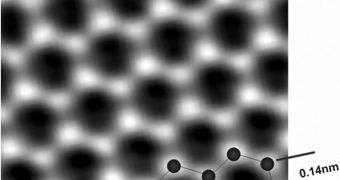Investigators have recently discovered that producing graphene-based circuits at a large scale has the potential to revolutionize the electronics industry, augmenting its capabilities beyond what is currently possible with silicon-based materials.
If the new carbon compound starts being used on a large scale, it could underlie the development of more compact and versatile circuit applications, that would be more feasible than what is doable today.
A group of scientists at the Rice University, in the United States, has demonstrated that employing graphene-based, triple-mode, single-transistor amplifiers in future electronic devices would lead to great improvements.
One of the most important things about graphene is that it exhibits a property called ambipolarity, which allows it to switch between operating with positive or negative carriers as it functions inside circuits and devices.
Experts say that the polarity the material takes is entirely dependent on the input signal. Details of the new work appear in this week's online issue of the esteemed scientific journal ACS Nano.
The main advantage graphene has over silicon is the ability to switch between carriers. Silicon transistors use only one of the two types of carriers, and the fabrication process determines which of the two is operated with.
Graphene can therefore underlie the construction of three-terminal single-transistor amplifiers that can be switched at any time between using positive or negative carriers, or both types at the same time.
According to Rice expert Kartik Mohanram, such opportunities are not possible with single-transistor architectures. He holds an appointment as an assistant professor of electrical and computer engineering.
The expert says that the new device is very much like a water tap. “Turn it on and the water flows. Turn it off and the water stops. That's what a traditional transistor does,” he explains.
“It's a unipolar device – it only opens and closes in one direction. But if you close a tap too much, it opens again and water flows,” he goes on to say.
“That's what ambipolarity is – current can flow when you open the transistor in either direction about a point of minimum conduction,” Mohanram explains.
University of California in Riverside (UCR) professor of electrical engineering Alexander Balandin, and students Xuebei Yang and Guanxiong Liu (Rice and UCR, respectively), were also a part of the research team.
The investigation was supported with grant money from the National Science Foundation (NSF) and the Focus Center Research Program at the DARPA-Semiconductor Research Corporation.
DARPA is the US Defense Advanced Research Projects Agency.

 14 DAY TRIAL //
14 DAY TRIAL //